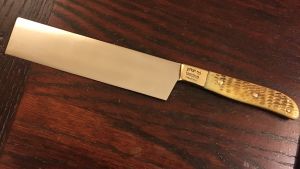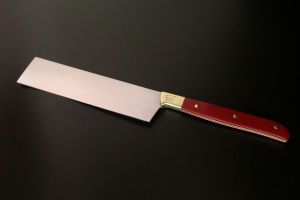Shechitah (Kosher Slaughter)
The Basics
The Torah prohibits the consumption of meat and fowl without prior ritual slaughter, known as Shechitah.
What is Shechita?
Excerpted from A Guide to Shechita 2009[1] by Shechita UK.'
- Shechita is the Jewish religious and humane method of slaughtering permitted animals and poultry for food. It is the only method of producing kosher meat and poultry allowed by Jewish law. It is a most humane method as explained below.
- There is no ritual involved in shechita. It is a cardinal tenet of the Jewish faith that the laws of shechita were divinely given to Moses at Mount Sinai (Deuteronomy XII, 21); the rules governing shechita are codified and defined and are as binding and valued today as ever and they ensure a swift and painless dispatch of the animal. Infringing the laws of shechita renders the meat unconditionally forbidden as food to Jews. The time allowed practice of shechita, marked as it is by compassion and consideration for the welfare of the animal, has been a central pillar in the sustaining of Jewish life for millennia.
- Shechita is performed by a highly trained shochet. The procedure consists of a rapid and expert transverse incision with an instrument of surgical sharpness (a chalaf), which severs the major structures and vessels at the neck. This causes an instant drop in blood pressure in the brain and immediately results in the irreversible cessation of consciousness. Thus, shechita renders the animal insensible to pain, dispatches and exsanguinates in a swift action, and fulfils all the requirements of humaneness and compassion.
The Mitzvot
There is one positive commandment to perform Shechitah, "VeZavachta... Ka'asher Tziviticha" (Devarim 12:21) and four negative prohibitions involved - Ever Min HaChai, Nevelah, Terefah, and Dam. "Nevelah" refers to an animal that was not slaughtered properly. "Terefah" refers to an animal that for one medical reason or another would not have lived out the year and is such prohibited from consumption even though it was slaughtered properly. Nevelot emit Tumat Nevelah (ritual impurity of Nevelah), whereas Terefot are Tehorot (pure).
What Does and What Does Not Need Shechitah
The Basic Rules
| Hebrew Term | English Term | Requires Shechitah | Requires Kisui HaDam | Details | Examples |
|---|---|---|---|---|---|
| Behemot Gassot | Large Mammals | Yes | No | Majority of two simanim | Cows |
| Behemot Dakkot | Small Mammals | Yes | No | Majority of two simanim | Goats |
| Chayot | Wild Animals | Yes | Yes | Majority of two simanim | Deer |
| Ofot | Birds | Yes | Yes | Majority of one siman | Chicken |
| Chagavim | Locusts | No | No | Just kill first | |
| Dagim | Fish | No | No | Just kill first | Salmon |
Exceptional Circumstances
- Ben Pakua: an unborn eight or nine month old baby found in a shechted animals womb that hasn't yet walked on the ground does not need Shechitah at all, but one shouldn't eat it until it's fully dead.[3] If it did walk on the ground or something else, it needs Shechitah MiDeRabbanan.[4]
When and Where to Shecht
See Timing and Location of Shechitah for more details.
- One may only slaughter during the day and/or with sufficient light.
- The Chachamim forbade slaughtering in a number of venues given their resemblance to pagan practices, specifically on the water and in a pit.
Who Can Be a Shochet
For more details, see Who Can Be a Shochet
In order to be a shochet, one must be an adult, God-fearing, Jewish male knowledgeable of the laws of Shechitah, skilled in the act of Shechitah, and certified with a "Kabbalah" from a Halachic authority. Special training is needed from a teacher with a tradition; one cannot just learn this skill from books or on his own.
In addition to the actual slaughter, there are a number of specific roles and designations:
- Shochet Ofot - certified for slaughtering fowl
- Shochet Behemot Dakkot - certified for small mammals
- Shochet Behemot Gassot - certified for large animals
- Bodek Simanim - one who checks the neck to ensure the Shechitah was done properly
- Bodek Sakinim - one who checks the Shochet's knife to make sure it's sharp and smooth before allowing him to shecht again
- Bodek - one who checks the inner organs to determine whether or not the animal is a terefah
- Menaker - one who removes the forbidden fats from the animal ("trabering").
The Knife

See The Shechitah Knife for more details.
One can perform shechitah with a variety of items, but nowadays everybody just uses a knife.[5] The knife must be sharp ("Chad") and smooth (Chalak) so that it can swiftly cut what it has to without tearing.[6] Different knife lengths are required depending on the width of the neck being slaughtered.[7] Knives are sharpened and polished with special whetstones and checked before use.[8] The shochet checks it from top to bottom from the center, right, and left with his fingernail.[9] The knife is commonly rectangular and not pointed, to avoid chaladah.[10]

The Five Laws of Shechitah Every Shochet Must Know
See The Five Laws of Shechitah for more details.
There are five Halachot leMoshe MiSinai regarding Shechitah. One may not eat from the slaughter of a shochet who does not know them.[11]
- Shehiyah (Pausing): A pause during the incision renders an animal’s meat non kosher. The knife must move in an uninterrupted motion and never be removed and then reapplied. This occurs if the shochet stops cutting, lifts the knife and then begins cutting again, but we are careful not to allow any pause, even if the knife is not removed from the neck. Such cases include a shochet banging his arm, elbow, or knife into an object, cutting himself; the animal jumping and causing a pause; or if there was something hard or stiff in the veshet during shechita.[12]
- Chaladah (Covering/Digging): The knife must be visibly drawn over the throat during slaughter. No covering or blocking it from the flesh by fur, feathers, or other objects. It must not be stabbed into the neck and cut backwards. To avoid this, sheep are sheered and other animal necks are hosed down beforehand.[13]
- Derasa (Chopping): The cut must be made using a back and forth sawing motion across the throat, not by chopping in a solely downward motion as one cuts a pumpkin or turnip. In order to ensure we do not come to chop, we’re careful not to push down with the index finger, use a heavier than necessary knife, decapitate, or hack at the neck.].[14]
- Hagrama (missing): The shechita cut must be made within a defined portion of the esophagus and trachea, this area is called the Makom Ha-Shechita. Cutting anywhere below or above this area would render the animal to be a nevelah. The makom ha shechita is located at the:
- Upper Kaneh (all animals): Today all are machmir to shecht below the large upper ring of the trachea
- Upper Veshet (all animals): below the turbatz ha-veshet (the area where the esophagus condenses)
- Lower Veshet & Kaneh (ofos): birds with crops at the top of the crop, birds without crops at the place where the wings connect to the neck
- Lower Kaneh (chayos/behemos): the top of the upper lobe of the lung when it is inflated
- Lower Veshet (chayos/behemos): the place where the esophagus begins to develop little hair like follicles as are present in the stomach.[15]
- Ikkur (Tearing): If either the esophagus or trachea is torn during shechita, the animal is rendered unkosher. Tearing usually occurs as a result of a nicked or improperly sharpened knife, but may also occur by tearing the esophagus or trachea by hand (usually only a concern in chickens, quail, or other small birds).[16]
How to Shecht
For more information, see The Shechitah Process, Intention During Shechitah, and Birkat HaShechitah
The Gemara requires checking the knife before and after every shechita in order to catch a pegima as soon as it happens. Chazal were concerned that the knife might contact dirt on the animal’s skin or hit a bone during shechita and receive a nick and become invalid.[17]
Before
- Check the knife
- Tefisah: Locate and grab the Simanim (trachea and esophagus)
- Recite the Beracha ("'Al HaShechitah'")[18]
During
- Severing the trachea, esophagus, carotid arteries, jugular veins and vagus nerve in a swift sawing action that immediately renders the chicken insensible to pain.
- Let blood drain out.
After
- Check the Simanim[19]
- Check the knife
Terefot (Treifos)
The eight basic issues in terefot are:
- Derusah: clawed at on specific parts of its body.
- Nequvah: a puncture on specific membranes in its body.
- Haserah: missing specific organs.
- Nitulah: a specific organ removed.
- Qiruah: a specific areas on its body torn.
- Nifulah: fallen from a high place.
- Pesuqah: specific body parts severed.
- Shiburah: specific body parts broken.
Nowadays, the lungs are the primary focus of Terefot checking. See Glatt Kosher Meat for more details.
Modern Day Industrial Shechitah
The details of Shechitah are numerous, but nowadays the process is much more standardized, streamlined, and audited by Kashrut agencies. See this page for more information.
Where to Learn
Every Talmid Chacham must be fluent in the laws of Shechitah.[20]
Classes
Important Sefarim
- Shulchan Aruch, Yoreh Deah 1-28
- Tevuot Shor, a commentary on Shulchan Aruch Hilchot Shechitah by Rabbi Alexander Sender Shor. (see this edition on HebrewBooks.org)
- Simla Chadasha, a classic handbook for Shochetim, Rabbi Shor's condensed version of his Tevuot Shor. Available in stores and on Sefaria. Translated into English by Rabbi Chaim Loike.
- Beis Dovid, the Ashkenazi classic on Hilchos Treifos.
- Zivchei Tzedek, the Sephardi classic on all matters Shechita and Terefot.
- Esek Hashechita by Rabbi Dovid Shaffier. See SeforimChatter Review here.
- Chullin Illuminated, Color Guide To Animal Anatomy With Halachic And Scientific Discussion, Rabbi Yaakov Dovid Lach, Feldheim Publishers
Shiurim
- Hilchos Shechita in Modern Meat Industry (Rabbi Avidan Elkin)
- Rabbi Avraham Moshe's classes
- IBC Experiential Halacha: Chicken Shechita
Sources
- ↑ A Guide to Shechita 2009
- ↑ Simla Chadasha 13:1
- ↑ Simla Chadasha 13:2
- ↑ Simla Chadasha 12:4
- ↑ Shulchan Aruch, Yoreh Deah 6
- ↑ Shulchan Aruch, Yoreh Deah 6
- ↑ Shulchan Aruch, Yoreh Deah 9
- ↑ Shulchan Aruch, Yoreh Deah 6
- ↑ Shulchan Aruch, Yoreh Deah 18
- ↑ Shulchan Aruch, Yoreh Deah 6
- ↑ Shulchan Aruch Yoreh De’ah 23:1
- ↑ Shulchan Aruch, Yoreh Deah 23
- ↑ Shulchan Aruch, Yoreh Deah 24
- ↑ Shulchan Aruch, Yoreh Deah 24
- ↑ Shulchan Aruch, Yoreh Deah 24
- ↑ Based on The rules of Shechita for performing a proper cut during kosher slaughter and The Five Disqualifying Acts - The Kosher Cut
- ↑ Chullin 10b
- ↑ Shulchan Aruch, Yoreh Deah 19
- ↑ Shulchan Aruch, Yoreh Deah 25
- ↑ Chullin 9a